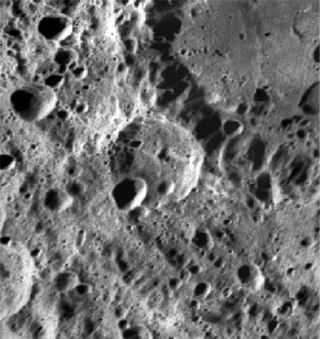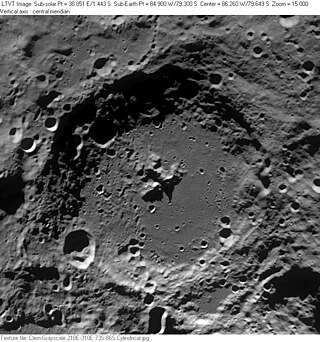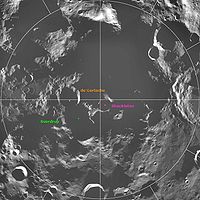
Moretus is a lunar impact crater located in the heavily cratered highland region near the south pole of the Moon.

Ashbrook is a large lunar impact crater that is located in the vicinity of the south pole on the far side of the Moon, and so cannot be viewed directly from the Earth. The eastern face of the crater has been overlain by the similar-sized Drygalski, and more than half the interior floor of Ashbrook is covered by the outer ramparts and ejecta of Drygalski. To the northwest is the walled plain Zeeman.

Byrd is an irregular lunar impact crater that is located near the north pole of the Moon. The north rim of Byrd is nearly connected to the crater Peary, a formation that is adjacent to the pole. The smaller crater Gioja is attached to the remains of the southwest rim.

Crommelin is an ancient lunar impact crater that is located in the vicinity of the south pole of the Moon, on the far side. It lies to the north of the large crater Zeeman, and to the east-northeast of Numerov.

Bohr is a lunar impact crater that is located near the western lunar limb, in the area that is affected by librations. It is attached to the southwestern rim of the larger, eroded Vasco da Gama formation, and to the southeast of the crater Einstein. The crater was observed for the first time in 1963, by Arthus and Ewen Whitaker in the book Rectified Lunar Atlas.

Boltzmann is an old lunar impact crater that is located along the southern limb of the Moon, in the vicinity of the south pole. At this location the crater is viewed from the side from Earth, and so not much detail can be seen. It is located to the north of the walled plain Drygalski, and to the west of the crater Le Gentil.

Brashear is a lunar impact crater on the far side of the Moon, in the southern hemisphere in the vicinity of the south pole. The crater is named after the American astronomer John A. Brashear. It lies just to the south of the walled plain Antoniadi, within the larger crater's outer rampart of ejecta. To the northeast besides Antoniadi is the crater Numerov, and southeast lies the younger De Forest.

Rozhdestvenskiy is a large lunar impact crater that is located on the far side of the Moon, within one crater diameter of the north pole. It lies sandwiched between the craters Hermite along the eastern rim, and Plaskett which intrudes slightly into the west-southwestern rim. Just on the opposite side of the pole is the crater Peary.

Belyaev is a lunar impact crater that is attached to the outer edge of the Mare Moscoviense, on the far side of the Moon. It is a worn formation with a small crater pair overlaying the southern rim, and several smaller craters across the relatively irregular interior.

de Gerlache is a lunar impact crater that is located along the southern limb of the Moon, within a crater diameter of Shackleton at the south pole. From the Earth this crater is seen from the edge, and it lies in perpetual darkness. Thus little or no detail can be seen of this crater, other than the edge of the rim. However, the crater is clearly visible in Earth-based radar images. The crater is roughly circular, with some slight wear. No craters of note overlie the rim, although some formations may be attached to the southern and western edges.

Birkeland is a lunar impact crater that lies in the southern hemisphere on the far side of the Moon. This crater is attached to the central waist of the oddly shaped Van de Graaff crater formation, and may partly account for that crater's figure-8 shape. To the southeast is the large walled plain Leibnitz.

Demonax is a lunar impact crater near the southern limb of the Moon. This location makes the crater difficult to observe due to foreshortening. The crater is also illuminated at a very low angle, when it is in the sunlit side. Demonax lies just to the north of the crater Scott, one of the south polar formations. To the north-northwest is Boguslawsky.

Drygalski is a large lunar impact crater that lies along the southern limb of the Moon. It partly overlies the crater Ashbrook to the west on the far side of the Moon. Just to the north of Drygalski is the smaller Boltzmann. The location of this crater restricts its observation from the Earth, and even under conditions of favorable libration it is viewed from the edge. It is only illuminated by the Sun at an oblique angle, and it lies close to the south polar craters that are permanently shielded from sunlight.

De Forest is a lunar impact crater on the far side of the Moon. It is located in the far southern hemisphere, to the west of the large walled plain Zeeman and due south of the crater Numerov. Because of its proximity to the southern pole, this crater receives sunlight at an oblique angle when it is on the illuminated half of the Moon.
Cooper is a lunar impact crater that is located in the northern hemisphere on the far side of the Moon. It lies to the east of the large walled plain D'Alembert, and west-southwest of the crater Chappell.

Nobile is a lunar impact crater that is located near the southern pole of the Moon. It lies to the south of the crater Scott, along the western rim of Amundsen. Between Nobile and the southern pole lie the smaller craters Shoemaker and Faustini.
Wiechert is a lunar impact crater that is located in the southern region of the Moon's far side. It lies to the southeast of the huge walled plain Schrödinger, less than 170 km from the southern pole.

Erlanger is a very deep lunar impact crater that lies near the north pole of the Moon. Due to its position near the lunar north pole, sunlight only rarely falls on the bottom, and the 2008 Chandrayaan-1 probe hoped to find that ice from comet impacts had accumulated there. Erlanger is one of the Moon's permanently shadowed craters.
Fibiger is a lunar impact crater located on the lunar near side near the northern pole. The nearest major feature is the Byrd crater. The crater was adopted and named after Danish pathologist Johannes Andreas Grib Fibiger in 2009 by the IAU. Located just north of Fibiger are craters Erlanger and Peary, which are 9.9 km and 73 km in diameter, respectively.

Cai Lun is a lunar impact crater located on the lunar far side near the northern pole. The crater is located in between the prominent craters Haskin and Nansen. Cai Lun was adopted and named after Chinese inventor Cai Lun by the IAU in August, 2010.


















